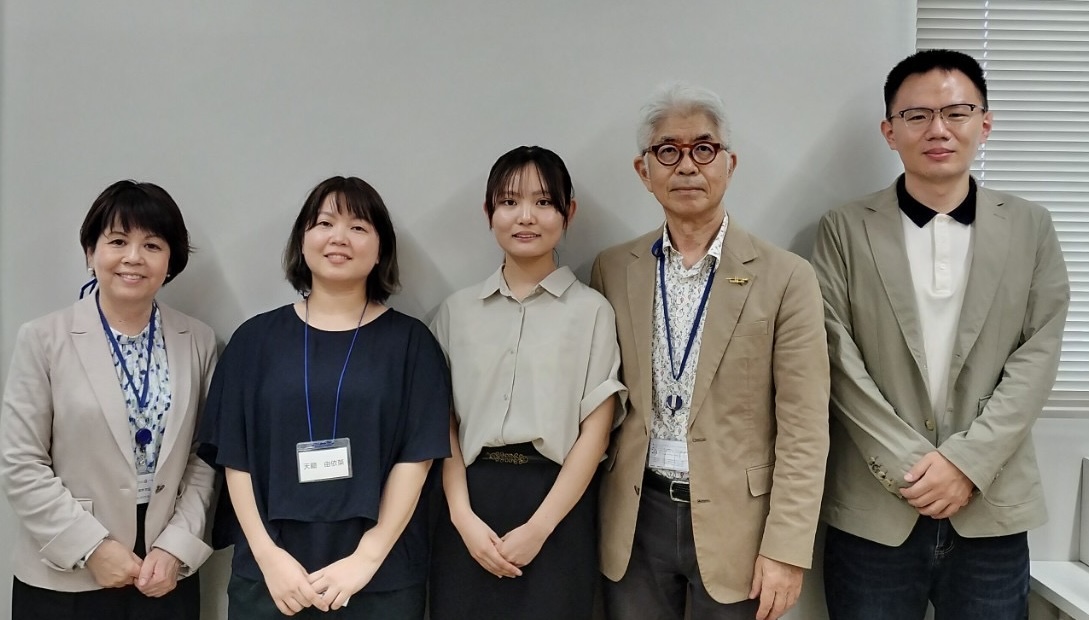
Fascinated by the movement of bacteria.
Tengan:
What led you to your current work? Could you tell us about the background and how it all started?
Xu:
Before coming to Japan, I worked in the Philippines for about four years, doing research on fungi and microorganisms. During that time, there was an international conference on parasitology held in the Philippines, and a professor from Tohoku University attended. We ended up talking about special plasma technology, and the professor asked, “Would you be interested in coming to Japan?” I thought, “That sounds interesting, maybe I should go.” So we exchanged emails afterward, and that’s how I ended up at Tohoku University.
At Tohoku University, I joined the Graduate School of Agricultural Science as a master’s student and was part of a laboratory studying zoonotic infectious diseases through animal microbiology. When it was time to choose a research topic, my advisor at the time, Professor Isogai, kindly said, “Why don’t you take a look at various labs first and then decide for yourself?” He was a very supportive professor.
So I visited a lab in the engineering department that studied bacterial motility and flagella. In that lab, they would record videos of bacterial cells and observe how each individual cell moved. Their motion looked like nano-machines, and I thought, “Wow, this is really cool!” That’s what sparked my interest in bacterial morphology and flagellar movement.
Uchida:
Was that Professor Shuichi Nakamura’s lab?
Xu:
Yes, that’s right. You know of it?
Uchida:
Yes, I attended the joint Global Health Conference in November and heard both Professor Nakamura and your lectures. I found your presentation very easy to understand.
Xu:
Thank you very much.
Photo from the U.S.-Japan Cooperative Medical Science Program (USJCMSP) panel meeting presentation on cholera.
Tengan:
What brought you to the University of the Ryukyus?
Xu:
The story is actually quite simple. At Tohoku University, I was doing research on Leptospira in an engineering lab. Dr. Toma was also conducting research on Leptospira at the University of the Ryukyus, and we got to know each other through that shared interest. We collaborated on Leptospira research for many years. When I visited the University of the Ryukyus for a research trip—at the time I was a postdoc—Professor Yamashiro invited me to join the university.
Tengan:
Were you already studying cholera at that time?
Xu:
I started working on cholera after coming to Okinawa. Professor Yamashiro was researching cholera and invited me to try working with Vibrio cholerae. Before that, my background was in Leptospira, Salmonella, and bacterial studies. I’ve always liked physics and math, so I found the biophysical aspects of bacterial motility and flagellar rotation particularly fascinating. Vibrio cholerae, like Leptospira, swims and moves. Since I was already interested in zoonotic bacteria in general, the shift from Leptospira to Vibrio cholerae felt natural. Now I study the morphological changes and motility of cholera bacteria, as well as how they respond to environmental stimuli—basically, bacterial physiology.
Uchida:
What do you find interesting or rewarding about your current research?
Xu:
I truly enjoy research, although most of the time, things don’t go as planned—actually, failure is more common. But that’s what makes it interesting. Unexpected discoveries and inspiration often come from those failures. For example, when I was at Tohoku University working on Leptospira, a collaborator sent me a sample and asked me to observe it. In our lab, we have a device that lets us observe bacterial motility. When we looked at the sample, its motion seemed normal. But when we increased the light intensity under the microscope, its movement suddenly sped up. Most bacteria don’t react to light, so it was totally unexpected.
Interestingly, the cholera strains we’re studying now—isolated from Okinawa’s Asato River—also respond to strong light. Their movement intensifies, and their flagella spin faster. We didn’t set out to discover this, but that’s the beauty of research—unexpected phenomena emerge.
Uchida:
On the flip side, what’s the most difficult part of your work?
Xu:
Even when we encounter difficulties in research or experiments, overcoming them is part of our job. So I don’t find that aspect particularly hard.
Bridging Basic and Clinical Research.
Tengan:
Do you have any dreams or goals for the future?
Xu:
Since I do basic research, I often get asked similar questions by students—like “How is this research useful?” Even as we focus on basic science, I always keep clinical applications in mind. We’re studying pathogenic microorganisms that cause diseases, so I’d like to see our findings contribute in some way to infectious disease control or clinical epidemiology.
Also, since I’ve been working in the lab for a long time, I haven’t had many fieldwork experiences. Right now, we’re collaborating with icddr,b—the International Centre for Diarrhoeal Disease Research in Bangladesh, probably the world’s largest institution specializing in diarrheal diseases. I’d really like to go there and engage in clinical research firsthand.
Uchida:
Do you think clinical research in the field differs from what you do here?
Xu:
Absolutely. People working in the field often find our basic science fascinating, and it’s equally important for us not to stay isolated in our lab. Being on the front lines teaches us a lot. For example, they actually go to patients’ homes to collect water samples for analysis, checking for infection sources. They also analyze patients’ vomit or feces—it’s incredibly valuable work.Right now, one of our projects involves studying the morphological changes of cholera bacteria. In the lab, we can artificially induce these changes, but clinical settings let us see what actually happens in the environment or inside patients. That’s what we can learn from being in the field.
Tengan:
Do you feel a strong connection between the two?
Xu:
Of course. We’re currently doing joint research through AMED and NIH projects. We invite collaborators to the University of the Ryukyus to learn about our work here, and we also visit field sites. I’m going to Bangladesh this April, and I hope to learn how clinical diagnoses are made on-site.
Tengan:
I didn’t know cholera bacteria could be found in Okinawa’s Asato River. Are there still infections?
Xu:
There were infections in the past, but they’re extremely rare now. These are environmental microorganisms, and it used to be difficult to isolate them from the environment.
Tengan:
Some diseases, like cholera, have very few cases in Japan. What do you think is the significance of Japan contributing to tropical medicine?
Xu:
I think the biggest contribution Japan can make is helping build international research and training networks, like those supported by NITM and JICA in Africa and Southeast Asia. Infectious diseases know no borders, so this kind of collaboration is meaningful.
My mentors—like my professor at Tohoku University and Professor Yamashiro—have worked through JICA in places like Zambia and Vietnam. They’ve helped establish local labs and even developed policy frameworks. I think that’s a significant role Japan can play.
Pursuing What You Love.
Tengan:
Was there anything in particular you worked hard on or were passionate about as a student?
Xu:
My academic background is in biology. Since I worked in an engineering lab at Tohoku University, I studied a lot of physics and math on my own, and I also picked up basic programming skills. Biophysics is fascinating, but to understand it, you need knowledge and techniques from various fields. So I studied hard to acquire them.
Uchida:
Since your interests span engineering and clinical fields, I imagine that was a challenge. As a biology major, did you face any barriers when learning about other disciplines?
Xu:
I think it’s relatively easy for someone in engineering to move into biology. But going from biology to engineering is definitely more difficult. Still, I believe you can do anything if you try. It’s all about effort.
Uchida:
Did you ever feel like giving up along the way?
Xu:
Not really—because I’m doing what I love.
Tengan:
Is there anything you’re currently mindful of in your daily life?
Xu:
When I have everyday conversations or watch the news, I try to stay aware of whether something might be useful for my research. It’s not that I actively seek out useful things—but when I see or hear various information, I naturally start wondering, “Could this be connected to my work?”
Tengan:
Do you have any advice for students who are interested in tropical medicine, or for members of the student division of the Japanese Society of Tropical Medicine?
Xu:
I’m not really in a position to give advice—I was a student myself not so long ago. But I do think that those who join the Society, like you two, already have a strong interest in or desire to be involved with tropical medicine. I’d say it’s important to always be aware of and remember why you’re interested in tropical medicine, or why you want to be involved.
Also, as Uchida-san mentioned, once you participate in the Society’s events, you’ll quickly realize how broad the field of tropical medicine actually is. It’s not a narrow niche at all. There are people like me doing basic research, but also many involved in clinical practice. You’ll also find experts in environmental science, epidemiology, policy-making, and education. There’s a huge diversity of roles.
So especially if you want to work as a physician and do research at the same time, it’s important to stay mindful of disciplines outside your own and continue moving forward with a broad perspective.

From left to right: Dr. Toma Claudia, Yuina Tengan, Miyu Uchida, Dr. Tetsu Yamashiro, and Dr. Jun Xu.
Profile of Interview Participants
Dr. Jun Xu
Assistant Professor, Department of Bacteriology, Graduate School of Medicine, University of the Ryukyus. Originally from China. Fluent in Chinese, Japanese, and English. Studied abroad at Centro Escolar University in the Philippines from 2010 to 2014. Completed his Ph.D. at the Graduate School of Agricultural Science, Tohoku University in 2019. Subsequently worked as a JSPS Research Fellow at the Department of Biophysical Engineering, Graduate School of Engineering, Tohoku University, conducting research on Leptospira. He assumed his current position in 2020. His current research focuses on the morphological changes and motility of Vibrio cholerae. As a student, he was a member of the basketball club.
Yuina Tengan
Third-year medical student at the Faculty of Medicine, Shimane University. Originally from Okinawa. Became interested in infectious diseases after reading a novel in elementary school. Aims to contribute as a “glocal” clinician—active both locally and globally. Hobbies include traveling and swimming. Active in a rural medicine research group, the Aikido club, and an international exchange circle. Motto: “If something catches your attention, respond to it.”
Miyu Uchida
Second-year medical student at the Faculty of Medicine, Nagasaki University. Originally from Shizuoka Prefecture. Entered the Faculty of Agriculture at Tohoku University in 2022. During her studies, her academic interests shifted toward medicine. She withdrew in her second year and entered Nagasaki University’s Faculty of Medicine in 2024. Her fields of interest include neglected tropical diseases (NTDs), zoonotic diseases, ecosystems, and basic research.

